In 2019, street artist OhPanda was inspired to reinvigorate the walls of Glasgow’s Sauchiehall Lane. Traditionally, it was a little-used thoroughfare, but it had seen a jump in foot traffic from street closures after the fire at Glasgow School of Art.
“The first painting that we got done was a mural by Mark Worst on the back of Sauchiehall Lane. And I was excited, but it was right before lockdown, and then lockdown kinda happened, and it was a bit strange.”
Strange though it was, this was the genesis of Colour Ways Glasgow – an artist-led organisation which curates murals with local communities, hosts walking tours, and runs street art and graffiti workshops with young people.
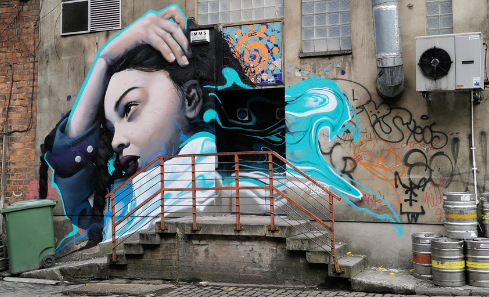
Mark Worst mural, Glasgow 2019. Image courtesy of Panda.
Today, street art is a big deal in Scotland. A quick Google and you’ll find results like the BBC’s coverage of artist The Bear who painted Glasgow’s walls during Covid, a VisitScotland list of top ten street art murals, and Absolute Escape's list of where to find the best street art in Scotland.
“I guess one of my main aims is to kinda change the perception of street art and graffiti,” says Panda. “For me, I'm really interested in the idea of it being an aesthetic judgment.”
“I would like to kinda explain that [graffiti and street art are] a lot deeper than people think. It's in museums all over the world. It’s really really rich. It samples from a lot of things. It holds a lot of value and reverence for other cultures as well. And it brings people together.”
Colour Ways Glasgow was originally inspired by a project called Open Close Dundee, which works with local artists to inject life into the city through street art and graffiti.
For Panda, the idea was simple and exportable – and even helped him come up with the name of his project. “[Open Close Dundee] focuses on painting doors in lanes and so that's actually why it's called Colour Ways. The idea is like colourful laneways.”
Having established the first set of murals for Colour Ways, in 2020 Panda got back in touch with G20 Youth festival who he’d worked with in 2019 doing street art graffiti workshops. “I said to them is it OK if I come back and just work with you guys after lockdown? And they were like yeah, definitely."
I think how you do it is by building relationships with them and just by being there, like as an artist- OhPanda
“I think the youth work for me definitely aligns with the idea of helping people express themselves. I'm always thinking that if you nurture the young person then they eventually will become the next person that's going to lead the way, and I think that's really inspiring.”
Colour Ways has grown since its beginnings in 2020: it now has a Board of Directors and, in summer 2021, Colour Ways received funding from Creative Scotland’s Open Fund to create an artist residency within G20 Youth Festival, including regular weekly activities with young people from the local area.
One of Panda’s favourite moments from the residency so far is an ongoing, evolving piece of art created by the young participants. Having been “obsessed” with artist’s studios and researching how they work, he noticed a common practice that he wanted to bring to the project.
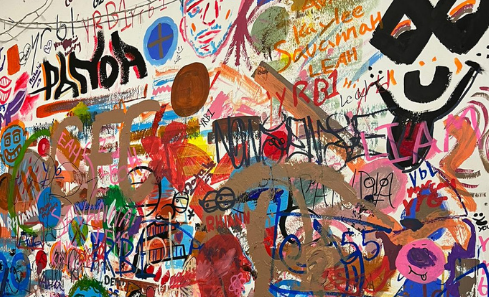
The Wall at the G20 Youth Festival building. Image courtesy of Panda.
“A lot of artists have these messy walls where they hang the canvas, but then on the actual wall they just scrape their brushes with the last bit of paint. And it ends up becoming a kind of beautiful artwork.”
"I just started kind of doing that with the young people at the end of the day when we finished with the paintings. Instead of just rinsing all the paint off the brushes, we go to the wall and we use the last of the paint.”
For Panda, it’s all about removing arbitrary barriers to being creative – like paper – and allowing the young people to embrace the artist within.
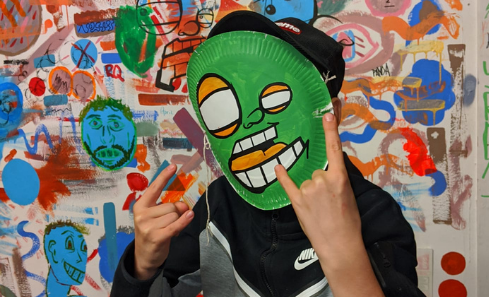
The wall at the G20 studio. Image courtesy of Panda.
“If you give a kid a crayon, they're not gonna go 'oh can I have a bit of paper?' They're just going to go to the wall and just write directly on the wall. It's totally inherent within us and that's part of my whole kind of ethos.’
The wall has become a focal point for the group and the first thing that new participants are introduced to when they come into the space.
“And I really like the fact that there’s an impermanence to it as well. Because within street art and graffiti, the essence of it is, it is impermanent. It comes and goes, and it's supposed to get painted over.”
The challenges of balancing guided participation and activities with a participant-led approach are especially important for Panda. His experience has taught him that, especially when it comes to working with young people at G20, you’re not going to get anywhere without getting them on board first.
“Strangely enough, I think how you do it is by building relationships with them and just by being there, like as an artist.”
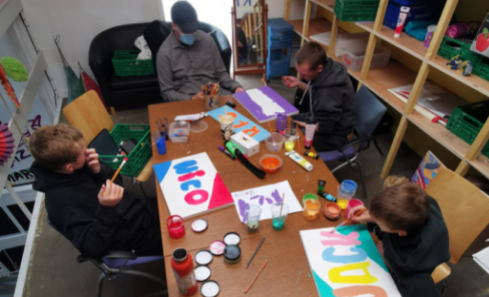
Panda and the project’s young participants during a workshop at G20. Image courtesy of Panda.
“I think often a lot of stuff feels as though it is kind of getting done to young people. I've really tried to avoid that because I don't want to be like ‘this is what we're gonna do today.’ I'm trying to leave it as open as possible.”
Panda’s approach is to let them express what they’re feeling at the time – and then explore and question on their own terms. “If you don't allow them to say the things that they want to say, then it's gonna mess up the kind of natural experience of creating art.”
Panda’s seen the benefit of this already in one of the participants who came up to him out of the blue with a question about his future.
“He was like, he's like 8 or something, and he's like "Are you an artist?" And I was like "Aye, I am. I'm an artist now."
“He's like "Do you think I could be an artist?" And I was like [speechless] and he says "I don't think I'm an artist but d'you think I could be? Would it be possible for me to be an artist?" And I was like "Honestly I never thought I was an artist man, I didn't know I was an artist. But I am now an artist so, you never know.”
Panda says it’s not about whether or not this boy eventually grows up to become an artist: it’s the fact that he’s been able to have the time and space to visualise it and see how it could happen.
“I think that's a lot of the thing, what we're missing, is just even having that wee ability to dream, or have like that idea that somebody could actually do is very limiting, especially when you grow up in schemes.”
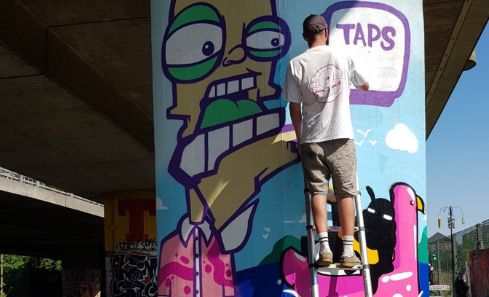
Panda creating a mural. Image courtesy of the artist.
Looking ahead means looking back for Panda, to his own experience of art and creativity in his childhood where he got to spend time in spaces and places where people could just gather and “coalesce around a vibe.”
“I think ultimately, I would love to own or run my own space. I really do like the idea of having a space because I would love to have a graffiti library.”
Creating a space where people have the right to gather and create without the barrier of an entry fee is vital for Panda. “I don't like the fact that people are left outside something just because they don't have money, like why should that be the case?”
“There's definitely other ways to live. It doesn't have to be this way.”
You can follow the latest updates from Colour Ways and explore their incredible body of street art and graffiti murals on their website, on Twitter, and Instagram.